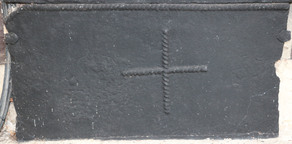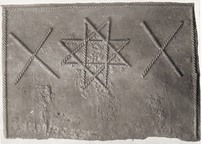-
1115
Description: Fragment; canted rectangular; twisted rope edging (topand sides); central cross of twisted rope.
Notes: Sections missing at both ends.
- Decoration tags:
- rectangular with canted top corners (shape)
- rope (edging)
- simple stamps
- apotropaic
- objects
Manufactured: in the 16th century in the Weald area of England.
Current location: in private hands, Crowborough, East Sussex, England.
- Attached to series:
- Rope design firebacks
-
69
Description: Rectangular; twisted rope edging (top and sides); twisted rope lengths parallel to top and both sides and crossing at corners, with shorter rope lengths across inside angles; shorter rope lengths arranged in three crosses across middle of plate, the middle one higher than the other two.
Notes: A particularly large and elaborate arrangement of rope lengths. The crosses suggest Christian significance.
- Decoration tags:
- rectangular (shape)
- rope (edging)
- simple stamps
- apotropaic
- objects
Manufactured: in the 16th century in the Weald area of England.
Current location: in private hands, Freshfield, East Sussex, England.
- Attached to series:
- Rope design firebacks
-
73
Description: Plain rectangular plate; print of a left hand, lower centre.
Notes: The excrescence above and to the left of the hand print shows where the pouring iron displaced the casting sand.
- Decoration tags:
- rectangular (shape)
- none (edging)
- simple stamps
- humans
Manufactured: in the 16th century in the Weald area of England.
Current location: in private hands, Groombridge, Kent, England.
- Attached to series:
- Hand print firebacks
-
78
Description: Sub-rectangular; twisted rope edging; lengths of twisted rope arranged to form two 'V' shapes and an 'I' overlapping to forma possible monogram.
Notes: The 'monogram' comprises different length pieces of rope and may have an apotropaic significance, the double 'V' referring to the Virgin Mary.
- Decoration tags:
- rectangular (shape)
- rope (edging)
- simple stamps
- apotropaic
- objects
Manufactured: in the 16th century in the Weald area of England.
Current location: Guildford Museum, Guildford, Surrey, England.
Museum number: G.488 (part of the Guildford Museum museum group)
- Attached to series:
- Rope design firebacks
-
115
Description: Plain rectangular plate with cross formed of a single length of twisted rope placed twice.
Notes: Despite the simple form, the likely Christian symbolism is very evident. Formerly part of the Ade Collection (from Grove Hill, Hellingly, Sussex).
- Decoration tags:
- rectangular (shape)
- none (edging)
- simple stamps
- apotropaic
- objects
Manufactured: in the 16th century in the Weald area of England.
Current location: Hastings Museum and Art Gallery, John's Place, Bohemia Road, Hastings, East Sussex, England.
Museum number: HASMG: 1952.51.17 (part of the Hastings Museum museum group)
- Attached to series:
- Rope design firebacks
-
921
Description: Canted rectangle; twisted rope edging (top and sides); central arrow-shaped design formed of three repeated rope lengths.
Notes: The arrow design probably has an apotropaic (evil-averting) purpose, perhaps intended as the initials VV for 'virgo virginum'.
- Decoration tags:
- rectangular with canted top corners (shape)
- rope (edging)
- simple stamps
- apotropaic
- objects
Manufactured: in the 16th century in the Weald area of England.
Current location: in private hands, Heathfield, East Sussex, England.
- Attached to series:
- Rope design firebacks
-
437
Description: Sub-rectangular; twisted rope edging (top and sides); centre, straight length of twisted material (rope or metal) stamped eight times to form an octagram, and twice on each side to form saltires.
Notes: The octagram has magical symbolism, allegedly providing protection against evil; it is more commonly seen on French firebacks. Formerly part of the J. H. Every collection. Illustration from Schubert, 1957.
- Decoration tags:
- rectangular (shape)
- rope (edging)
- simple stamps
- apotropaic
- objects
Manufactured: in the 16th century in the Weald area of England.
Current location: Anne of Cleves House, Southover High Street, Lewes, East Sussex, England.
Museum number: 1944.24.038 (part of the Sussex Archaeological Society museum group)
Citation: Mercer, H. C., 1961, The Bible in Iron (3rd ed. Doylestown, The Bucks County Historical Society).
- Attached to series:
- Rope design firebacks
-
441
Description: Sub-rectangular; edged with a repeated length of helically-turned dowel (top and sides); apparently random arrangement of same piece of dowel repeated ten times, including a saltire and cross.
Notes: Apart from the Christian significance of the cross, the other arrangements of rope lengths may be apotropaic in their purpose, the double V being a possible invocation of the Virgin. The blemishes at the base are caused by the casting sand being disturbed by the pouring of the metal.
- Decoration tags:
- rectangular (shape)
- rope (edging)
- simple stamps
- apotropaic
- objects
Manufactured: in the 16th century in the Weald area of England.
Current location: Anne of Cleves House, Southover High Street, Lewes, East Sussex, England.
Museum number: LH000.799 (part of the Sussex Archaeological Society museum group)
Citation: Dawson, C., 1903, 'Sussex Iron Work and Pottery', Sussex Archaeological Collections, 46, pp. 1-54.
Citation: Gardner, J. S., 1898, 'Iron Casting in the Weald', Archaeologia, 56, 1, pp. 133-164.
- Attached to series:
- Rope design firebacks
-
455
Description: Canted rectangle; twisted rope edging (top and sides); a rope saltire in each top corner.
Notes: The edging is made from the same, short lengths of rope as the saltires.
- Decoration tags:
- rectangular with canted top corners (shape)
- rope (edging)
- simple stamps
- apotropaic
- objects
Manufactured: in the 16th century in the Weald area of England.
Current location: Hall Place, Bexley, Kent, England.
Museum number: 1944.24.049 (part of the Sussex Archaeological Society museum group)
- Attached to series:
- Rope design firebacks
-
457
Description: Fragment; right part, prob. rectangular; twisted strip edging (top and sides); stamp of firedog with semi-circular feet, and with shields at top and bottom of shaft, the lower with quartered arms, the upper with diagonal bar over a rectangle (gate?); horizontal twisted strip length to left of firedog.
Notes: The twisted lengths clearly show the flattened form of a strip of material (poss. leather).
- Decoration tags:
- rectangular (shape)
- twisted leather (edging)
- simple stamps
- objects
Manufactured: in the 16th century in the Weald area of England.
Current location: Anne of Cleves House, Southover High Street, Lewes, East Sussex, England.
Museum number: LH000.914 (part of the Sussex Archaeological Society museum group)
- Attached to series:
- Firedog stamp firebacks
- Metalware stamp firebacks









